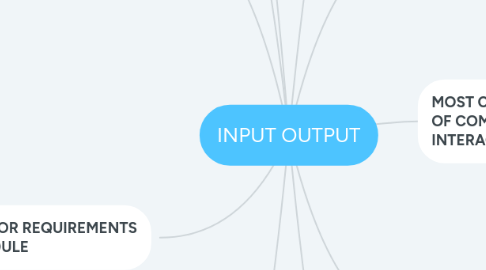
1. INTRODUCTION
1.1. a device which is connected to an i/o module of computer is called peripheral device.
1.2. I/O modules is normally connected to computer system on one end and one or more I/O devices on other.
1.3. set of i/o modules is third element of computer system
1.4. I/O modules contains logic for performing a communication between peripheral and the bus & not simply a set of mechanical connectors that wire a device into system bus.
2. I/O module
2.1. wide variety of peripherals
2.1.1. delivery different amounts of data
2.1.2. at different speed
2.1.3. in different formats
2.2. peripheral often use different data formats & word lengths than computer to which they are attached
2.3. data transfer rate is much slower than memory or processor.
2.4. but data transfer some peripheral is faster than memory or processor.
2.4.1. this might lead to inefficiencies if not managed properly
3. I/O MODULE
3.1. has two major functions
3.1.1. 1. interface to the processor and memory via system bus or central switch
3.1.2. 2. interface to one or more peripheral devices by tailored data links
4. EXTERNAL DEVICES /PERIPHERAL DEVICES.
4.1. human readable
4.1.1. communicating with computer user
4.1.1.1. eg. video display terminals
4.1.1.2. printers
4.2. machine readable
4.2.1. communicating with equipments
4.2.1.1. eg- magnetic disks
4.2.1.2. sensor
4.2.1.3. actuators used in robotics application
4.3. communication
4.3.1. communicating with remote devices
4.3.1.1. eg- Network interface Card(NIC)
5. INTERFACE TO EXTERNAL
5.1. interface to I/O module is in
5.1.1. control
5.1.2. data
5.1.3. status signal
5.1.3.1. control signal
5.1.3.2. data signal
5.1.3.3. status signal
6. MOST COMMON MEANS OF COMPUTER/USER INTERACTION
6.1. keyboard
6.1.1. provides input that transmitted to computer
6.2. monitor
6.2.1. display data provided by the computer
7. FUNCTIONS OR REQUIREMENTS FOR I/O MODULE
7.1. control and timing
7.1.1. to coordinate the flow of traffic betwen inter resources and external devices
7.2. processor communication
7.2.1. command decoding
7.2.2. data
7.2.3. status reporting
7.2.4. address recognition
7.3. device communication
7.3.1. command
7.3.2. status information
7.3.3. data
7.4. data buffering
7.4.1. an essential task of I/O modules
7.5. error detection
7.5.1. i/o modiles often responsible for error detection & reporting errors to processor
7.5.1.1. one class of error include mechanical & electrical malfunctions reported
7.5.1.1.1. example is paper jam & bad disk track
7.5.1.2. another class consist of unintentional changes to the bit pattern
7.5.1.3. some form of error detecting code often used to detect transmission errors
8. PROGRAMMED I/O
8.1. refer to data transfer initiated by CPU under driver software control to acces registers or memory on a device
8.2. worked in these ways:
8.2.1. CPU request I/O operation
8.2.2. I/O modules performs operation
8.2.3. I/O module sets status bits
8.2.4. CPU checks status bits periodically
8.2.5. I/O module does not inform CPU directly
8.2.6. I/O module does not interrupt CPU
8.2.7. CPU may wait or come back later
9. INTERRUPT DRIVEN I/O
9.1. overcome CPU waiting
9.2. no repeated CPU checking of device
9.3. I/O module interrupt when ready
9.4. basic operations of interrupt
9.4.1. CPU issues read comment
9.4.2. I/O module gets data from peripheral whilst CPU does other work
9.4.3. I/O module interrupt CPU
9.4.4. CPU request data
9.4.5. I/O module transfer data
10. DIRECT MEMORY ACCESS(DMA)
10.1. a feature of computer systems that allow certain hardware to access RAM indepently of central CPU
10.2. a way for I/O devices to bypass CPU when accessing memory
10.3. interrupt driven and programmed I/O require active CPU intervention
10.3.1. transfer rate is limited
10.3.2. CPU is tied up
10.3.3. DMA is the answer
10.4. DMA functions
10.4.1. additional module (hardware) on bus
10.4.2. DMA controller takes over from CPU for I/O

